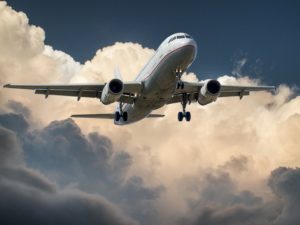
An airplane’s wings are shaped like an upside-down airfoil, which means they’re curved on the top and flat on the bottom. This shape allows the airplane to generate lift, which is what helps it rise into the air and stay in the air. When the airplane is moving through the air, the air flows over the curved part of the wing and creates a difference in air pressure. The higher pressure on the bottom of the wing pushes the wing upward, generating lift.
But how does an airplane move through the air in the first place? That’s where the engines come in. Most airplanes have jet engines, which work by sucking in air at the front, mixing it with fuel, and burning it to create a hot, high-pressure gas. This gas is then forced out of the back of the engine through a narrow opening, creating a forward thrust that propels the airplane through the air.
The pilot can control the direction of the airplane by using the rudder, which is a hinged surface at the back of the airplane that helps steer it left or right. The pilot can also control the airplane’s altitude by using the elevator, which is a hinged surface at the back of the wing that helps raise or lower the nose of the airplane.
There’s a lot more to it than that, of course, but those are the basic principles behind how airplanes work. So next time you’re on a plane, just remember: it’s all about the wings, the engines, and the rudder and elevator!
Projects to Try at Home
Build a paper airplane: This is a classic experiment that can help you understand how the shape of an airplane’s wings affects its flight. You can try making different designs and see how they fly differently.
Make a wind tunnel: You can create a homemade wind tunnel by using a cardboard box, a small fan, and some plastic sheeting. You can then use this wind tunnel to test different shapes and see how they are affected by air flow.
Experiment with lift and drag: You can use a toy airplane or a model airplane to test the principles of lift and drag. You can do this by attaching the airplane to a string and pulling it through the air, or by using a small wind tunnel to test different shapes and configurations.
Build a model airplane: Building a model airplane can be a fun and educational project that can help you understand how airplanes are constructed and how they work. You can find model kits at many hobby stores, or you can design and build your own using materials such as balsa wood and plastic.
Resources for Further Study
The Federal Aviation Administration (FAA) has a website that provides a lot of information on the basics of flight, including how airplanes work. It’s a great resource for anyone who wants to learn more about the principles of flight in an interactive and easy-to-understand way.
https://www.faa.gov/education/students/resources
https://howthingsfly.si.edu/
The website HowStuffWorks also has a lot of detailed articles on how airplanes work, as well as other topics related to aviation.
https://www.howstuffworks.com/
If you’re interested in learning more about the mechanics of flight and the engineering behind it, you might want to check out the book “Fundamentals of Aerodynamics” by John D. Anderson Jr. This textbook is used in many college-level aerodynamics courses and provides a comprehensive overview of the subject.
https://www.amazon.com/Fundamentals…/dp/1259129918
